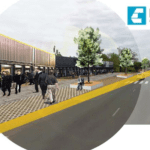Design and Analysis of Cable-Stayed Bridges
Cable-stayed bridges are some of the most iconic and aesthetically appealing structures in the world, known for their elegant design and efficient use of materials. This article explores the intricacies of designing and analyzing cable-stayed bridges.
It delves into the engineering principles, structural components, and the various factors that influence the design process. Additionally, the article highlights the importance of advanced technology and software in optimizing cable-stayed bridge designs.
Introduction:
Cable-stayed bridges are a remarkable fusion of engineering and art, featuring towering masts and an intricate network of cables that support the deck. They are known for their graceful appearance and are often chosen as landmarks in many cities around the globe.
Behind their beauty lies a complex design and analysis process that ensures their structural integrity, safety, and functionality. This article will provide an in-depth look into the design and analysis of cable-stayed bridges.
Structural Components:
Cable-stayed bridges are composed of three primary structural components:
- Pylon or Tower: The tall pylon or tower stands as the backbone of the bridge. It supports the weight of the deck and transfers the loads to the foundation. The pylon is a vital design element, both in terms of aesthetics and functionality.
- Stay Cables: Stay cables are tensioned wires or strands that connect the pylon to various points on the bridge deck. They play a critical role in distributing the bridge’s weight to the ground. The arrangement and tensioning of these cables are crucial in the bridge’s stability.
- Bridge Deck: The bridge deck is the part of the structure that supports the traffic load. It is usually made from various materials, such as concrete, steel, or a combination of both, depending on design requirements.
Design Principles:
The design of cable-stayed bridges follows a set of fundamental principles:
- Load Analysis: Engineers assess the anticipated loads on the bridge, including the weight of the deck, live loads (traffic), wind loads, seismic forces, and temperature effects. These loads are used to determine the required strength and stiffness of the structure.
- Optimal Cable Arrangement: The arrangement and distribution of stay cables play a critical role in the bridge’s aesthetics and structural efficiency. Various cable configurations, such as fan, harp, and semi-harp arrangements, are considered to achieve the desired visual effect and structural stability.
- Pylon Design: The pylon’s height and shape are significant design elements. The pylon must be designed to withstand bending moments, torsion, and axial forces while adhering to architectural and aesthetic requirements.
- Material Selection: The choice of materials for the bridge deck, pylon, and stay cables depends on factors such as span length, environmental conditions, and budget. Modern cable-stayed bridges often use high-strength materials like high-performance concrete and high-strength steel.
Analysis and Simulation:
Advancements in structural analysis software have revolutionized the design process for cable-stayed bridges. Engineers use finite element analysis (FEA) and computer-aided design (CAD) software to simulate and assess various design options. This enables them to optimize the bridge’s structural performance and refine its appearance.
Challenges and Innovations
Designing cable-stayed bridges is not without challenges. Engineers must consider wind-induced vibrations, aeroelastic effects, and dynamic behavior, especially in long-span bridges. To address these challenges, modern cable-stayed bridge designs often incorporate tuned mass dampers and other vibration mitigation techniques.
Innovations in materials, such as carbon fiber-reinforced composites for cables and advanced construction methods like incremental launching, have also improved the efficiency and sustainability of cable-stayed bridge projects.
Conclusion
The design and analysis of cable-stayed bridges involve a delicate balance between aesthetics and engineering. These iconic structures serve as both functional transportation links and works of art. The use of advanced technology, materials, and analysis methods has allowed engineers to push the boundaries of what is possible in cable-stayed bridge design, resulting in structures that are not only safe and efficient but also awe-inspiring in their architectural beauty.
As the field of structural engineering continues to advance, we can expect even more impressive and innovative cable-stayed bridges to grace our skylines.
Disclaimer: This content is provided solely for your review. Erusu Consultants takes no liability for this article. The reader is advised to form their own opinion. Please consult a Structural Engineer before making any final decisions.






